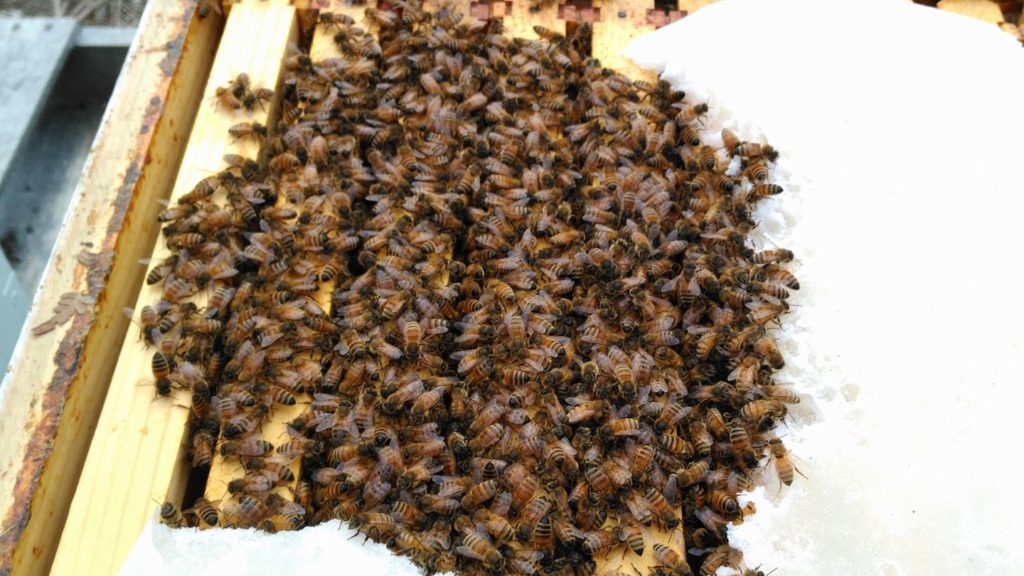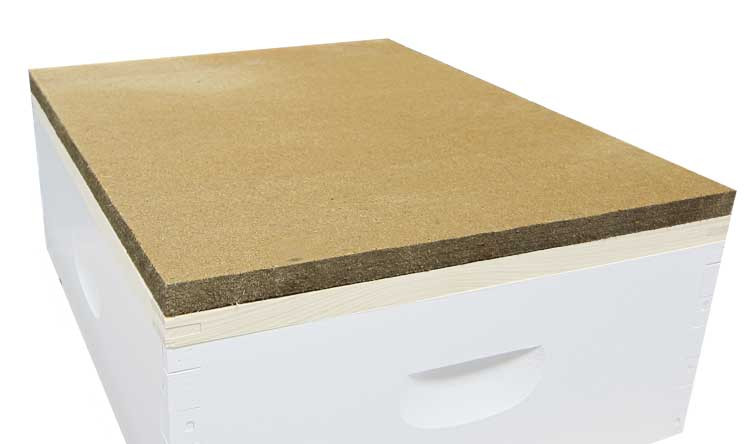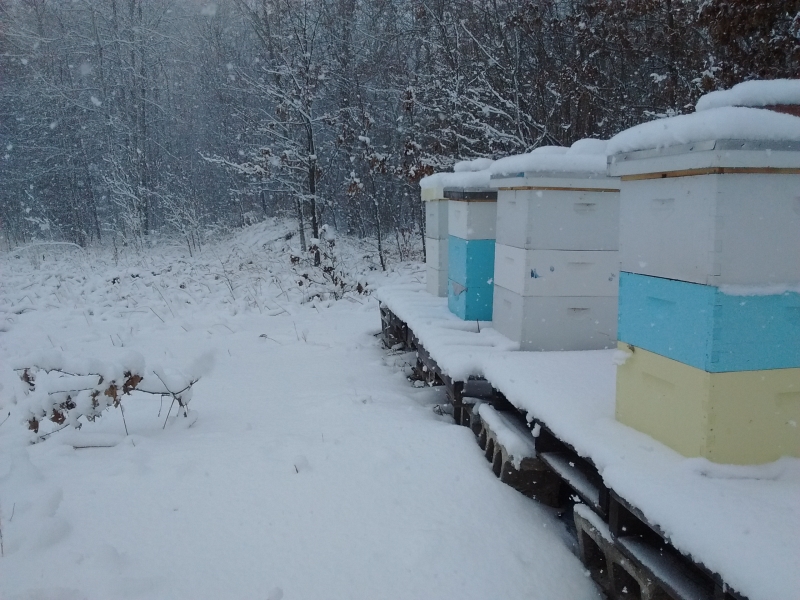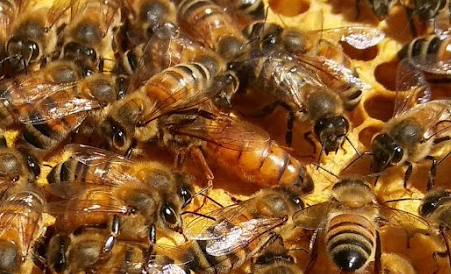It’s already September? Where did the time go? It seems each bee year passes more quickly than the last, and now that the leaves are starting to turn colors here in West Michigan, I have to start dreading the cold half of the year. Shoveling, scraping, salting and freezing is what I have to look forward to until the Maples and Willows start producing pollen in March. That being said, the bees have been preparing for winter all year and at this point each action you take can have drastic effects. That leads us to one of the most important questions a beekeeper can ask, “How do I overwinter my bees?”
First let’s look at what the bees do naturally during cold periods and winters, to make sure that nothing we do to help them gets in the way or impedes their natural methods.
HOW BEES DEAL WITH WINTER
As the days get colder and the nights grow longer the bees start preparing themselves for the long, cold winter. The brood nest gets smaller, the honey stores, once relegated to the outer friames and high above the brood nest now invade the brood frames making each frame heavy with energy rich carbohydrates. The cracks and crevices that once provided cooling ventilation are now tightly sealed with propolis and the drones that were so pivotal to the local area’s bee propagation are now deemed unnecessary and are unceremoniously kicked out.
One of the more amazing changes that happen to a bee colony entering the winter months is the development of “winter bees”. These are bees with enlarged fat bodies that allow survival for months on honey or sugar alone and even give the bee the ability to produce protein rich brood food in an absence of fresh pollen. This period of winter bee rearing is probably the most important few weeks of the bee year. There will be no other chances to increase the winter bee population, if they miss this small window or for any reason they are unable to create a sufficient amount of these “fat bees”, the colony is on borrowed time.
The process the bees use to develop these specialized workers is similar to the process used to create a queen bee (or rather, the process that separates the development of a queen from a worker). When creating a queen it is the lack of pollen and nectar and the surplus of royal jelly fed to the young larvae that allows the ovaries to fully develop and creates a distinctly different bee. When creating a winter bee it is the relatively low level of protein fed to the larvae that kick up the production of fat bodies and the compound vitellogenin, a glycolipoprotein with properties of sugar, fat and protein that give nurse and winter bees a greater immune system and allows winter bees to consume and dispense nutrients that aren’t readily available in the hive or the field. This incredible use of external conditions to implement epigenetic changes is truly one of the most fascinating things about this lovable creature we’re all trying to keep alive.
Enter for the first time our arch villain the varroa mite. Would-be winter bees infested by the varroa mite as pupae do not have the ability of a non-infested worker to build these fat bodies and store vitellogenin. So, mite management practices prior to the rearing of these winter bees is crucial to their survival. More on this later.
After the production of these specialized fat bees comes the freeze. At this point the brood level is severely diminished and the egg laying portion of the year is usually complete. When the outside air temperature falls into the low 50’s Fahrenheit the bees huddle together to create a temperature regulating cluster that expands and contracts to keep the cluster at a very specific set of temperatures. When there is no brood present the cluster temperature usually stays about 85, when there is brood present the thermostat is raised to 93. This fact is why cold weather brood manipulation and early pollen feeding can cause havoc inside the hive as the bees try to maintain temperatures high enough for the brood to develop despite not having enough bees or food to contribute to this effort.
Just as is the case with any other job a colony does, their efforts when clustered are varied and distinct. While nurse bees continue the job of taking care of the remaining brood, the outer layers of bees detach their wings from the muscles that move them, allowing them to vibrate those muscles to generate heat. When the outer layers become too cold they are moved toward the center of the cluster to warm up while a new set of bees takes up the heat generation job. This method of heat maintenance is not the furnace that spreads warmth throughout your house in the winter, rather than heat the entire cavity of the hive the bees only expend enough energy to heat the cluster. Think of it more like relying on a heating blanket draped over your shoulders for warmth rather than a system that warms the air inside your house. Infrared images of clustered bees show the whole story with the bright red/orange of the cluster surrounded by temperatures barely higher than the outside air. The warm, moist air that does leave the cluster rises inside the hive until it reaches a cold surface, where it condenses into water droplets and threatens the colony below like a thermodynamic Sword of Damocles. If this moisture builds up enough, it will drip onto the colony, reducing their ability to maintain proper temperatures and threatening a quick, cold death.
The cluster will work its way throughout the hive following the honey, but primarily moving upwards, presumably following the heat rising from the group. This movement is slow and sometimes not possible due to frigid cold, causing colony deaths due to starvation even when there is ample honey to the side, below or even above the cluster. This is why the ubiquity of sugar is an essential element to any northern honey bee colony’s survival. It’s not just enough to have the right amount of honey or sugar, it has to be in the right place for easy access.
During these clustered months, the bees eat enough to maintain, which, obviously brings the requirement of ridding themselves of waste. Their ability to “hold it” is profound but not limitless, and the buildup of bee poop inside the hive can bring on unhealthy conditions. That is why it is so important to allow the bees access to the outside at all times, no matter how many dead bees are clogging the main entrance, by giving them a secondary, or “upper” entrance. When the outside air temperature climbs above 50 and the sun is shining, the bees race outside to paint the snow with their orange waste, sometimes covering the lids and sides of the boxes as the need grows too great to wait another second. If the amount of poop on the lids surprises you, know that it is a good thing as it means a reduction in overall stress on the colony.
As the days start finally to grow longer and the mercury begins to rise, those fat bodies existent in the winter bees exhibit another area of importance for the colony’s continuation and growth. The queen starts laying small patches of brood and even without incoming fresh pollen the fat nurse bees produce protein rich royal jelly to feed the new spring bees. The brood patch grows slowly with the length of the day until the first abundant sources of pollen herald the end of winter. Here in Michigan our first real sources of pollen are Maple and Willow trees and the sight of those bees coming in with sacks full of groceries is an exciting and encouraging thing.
During these first few days of spring the bees will expend more and more effort foraging, cleaning house and tending to the growing brood nest. This means their reliance on the winter food stash is not done, pollen abundance does nothing for the bee’s need for sugar and with more activity inside the hive, honey, sugar or nectar is a necessary fuel. Only when the first sources of nectar become abundant, usually dandelions, are the spring colonies able to breathe a sigh of relief.
So, what can we take away from our model hive and use to our advantage when it comes to overwintering our beloved bees?
HOW TO WORK WITH NATURE TO OVERWINTER NORTHERN COLONIES
Mites
The first requirement to successfully overwinter a hive, or, overwintering a hive that will impress you in the spring with population, vigor and build up, is a low mite load. I will not advocate any single method of mite load mitigation, but, hopefully you follow the “build a better bee” philosophy and take special care to advance yourself toward a mite resistant and sustainable stock, rather than treating every colony with miticide and propagating regardless of mite resistant traits. That being said, the importance of keeping the mites in check cannot be overstated. Mite populations are directly correlated to the bee population in a hive, with a phase difference, meaning as the bee population starts to dwindle in August, the mite population soars. At this point in the year the mite:bee ratio can explode and reduce what was a vibrant and productive colony to a dead-out before you open presents on Christmas morning.
Food

With the mite load in check the next thing to think about is food. On this topic there are endless debates between beekeepers about whether it is unnatural or unhealthy to feed our bees granulated sugar or sugar syrup. I won’t venture into that ideological debate here, but I will put it this way, if there isn’t enough honey, you must feed your bees if you wish to see them in April. Whether you took all or most of the honey, performed a late season split, or maybe there was a long late summer dearth, regardless of how you got into this position, you must give them honey or syrup to store. The next debate between beekeepers is what source of the sugar is best, beet or cane? Argue about that one all you like but the fact remains that the sugar refining systems in place are so efficient, what ends up in the store is almost pure sucrose. I personally make my decisions on which sugar to purchase based on another important factor, price. The only true rules when deciding on what to feed your bees are nothing brown, raw or unrefined. The remaining molasses in these raw sugars are without a doubt detrimental to your goal and should be avoided. An interesting note on this subject is one of “ash content”. Ash content refers to the remaining weight after incineration of a food sample and can be looked at as the ratio of a food’s overall weight to the usable energy it contains. For bees to get the most of the food they eat during winter and have the least bit of waste after the fact, a purer form of energy is superior and in most cases of nectar vs sugar, sugar reigns supreme. That is not to say that a colony of bees would be better off consuming only white granulated sugar for the entire year, there are nutritive elements to honey that are not evident in sugar, but for winter sustenance, sugar is at the very least a viable alternative to the more natural honey the bees work so hard to create.
The amount of food required to overwinter a colony is not a question with a true and invariable answer. That depends on your geographic and topographic location, the length and severity of your winter, the amount of bees in your hive, the volume of the cavity the hive calls home and many other significant but less overt factors. The only rule I adhere to on this subject is, err on the side of too much, rather than too little. In addition to feeding thick syrup in the fall, before the snow falls and accumulates, I cover the tops of the frames in the top box of each hive with sugar bricks. I have used dry sugar and many different recipes for sugar bricks and have never found any one dry feeding method to be superior. My current methods are about as straightforward as it gets, I mist dry sugar with water until it cakes, let it dry and break up the pieces for placement on the frames. This method has a neat multitasking feature that utilizes dry sugar’s hygroscopic (absorbs moisture from the air) nature to absorb moisture rising from the clustered bees.
Ventilation
This section is where it becomes difficult to separate our human nature from our assessment of a honey bee colony’s winter readiness. Ventilation, however counter-intuitive, is a necessary factor required to help deal with moisture and rid the hive cavity of accumulated carbon dioxide. That being said, there should not be large cracks or seams in your hive’s construction, keeping the entrance fully open and providing an upper entrance (an upper entrance shim is also a multitasker as it gives space for sugar, provides an exit when the main one might be clogged, and gives moist warm air a place to escape) is usually sufficient.
Moisture Control

The dry sugar at the top of the hive and ample ventilation are both great methods of moisture control but sometimes even all of that can end up being insufficient and as is true with the food, it is better to err on the side of more rather than less. For that reason we utilize moisture boards above the inner cover to absorb any remaining ambient moisture and provide insulation for the cover which helps by causing the top of the hive to no longer be the coldest surface that is most prone to condensation. There are many inventive beekeepers coming up with varying tools to aid in this effort. Some people build quilt boxes, fill shims with wood shavings or even stuff the lid with burlap sacks. The choice is yours, but the moisture boards available at many beekeeping supply stores are effective and cheap.
Mouse Guards

Field mice search frantically for suitable winter homes during the fall and if your bees are clustered due to the cold, they may not be able to deter the mouse effectively. Put up mouse guards at the end of summer and save yourself the hassle of trying to repair the tiny mouse’s destructive inhabitance. You can buy specialized mouse guards from most beekeeping supply stores or save yourself some money and buy #8 hardware cloth from your local hardware store and staple it to the face of the hive and the bottom board.
Wind Break
Help your bees maintain their desired cluster temperature by finding a spot in your bee yard with some protection from the cold winter winds. If there are no natural obstructions available you can construct something to aid in this effort or move your bees somewhere that will provide some level of wind protection. I don’t normally advocate wrapping a highly populated hive in insulation wrap but if finding an area away from the wind is completely outside of your means, that might be a viable alternative.
Colony Population
I have never seen anything to indicate the fact that it takes a large colony to make it through a long, tough winter. We overwinter many single deep boxes with great success and I know of many northern beekeepers with a lot of successful history overwintering 5 frame nucs. That being said, a small colony should only be small by design, whether you performed a late season split or want to try your hand at wintering nucs, not because of disease, mite infestation or queen failure. The added stresses of the winter will almost always prove to be too much for a colony dealing with the other stressful factors that led to its low population. So, combine your weak colonies and take your losses in the fall and take extra care in preparing “small by design” colonies so they don’t have to deal with any unnecessary difficulties.
Winter Management
While you are sitting inside looking through the frosty window longingly at your bee yard you will be tempted to walk out there and investigate and while there are reasons why you should inspect your bees during winter, curiosity is not one of them. You should have some idea as to how long your bees have before their food stores sink to dangerously low levels and if you practiced proper winter preparation techniques during the fall there should be no risk of running out of food until well after the New Year’s ball drops. So, wait for a calm, sunny day with temperatures above 40 degrees to head out and get an idea about the remaining food levels. Bring with you some more sugar bricks or a bag of dry sugar for feeding. Start by lifting up the back of the hive, if it is very light you don’t need to go any further, they need food. If it feels as if there is some heft to it but you’re not sure, peek under the lid to see if they have reached the dry sugar at the top of the hive. If you see them under the inner cover or if they have eaten a good portion of the dry sugar stores, they need food. You can’t feed syrup during the winter or during any period of threateningly low temperatures, so place sugar bricks on the top of the frames, or cover the top of the frames with a sheet of newspaper and pour a mound of white sugar onto the paper (this is called the Mountain Camp method of feeding). Another helpful thing you can do during the winter other than casual observations for wind swept lids and errant tree branches is clean the entrance of dead bees. Pull your mouse guard aside and use a twig or hive tool to scoop out the fallen bees, remember not to be alarmed at the amount, the summer bees never had a chance to make it through winter. Other than those few things there is nothing more you can do for your bees during the winter. Further inspections only break propolis seals and lower the internal temperatures, forcing the bees to use energy restoring the proper conditions.
Conclusion
In conclusion, bees need to be healthy, they need ample food, ventilation, moisture control, protection from the wind and from invading creatures, to survive here in West Michigan. The requirements for you might differ but if you go into each winter with a full understanding of your bee’s natural tendencies and of the perils your region poses, you can work with them to provide all they need to sustain until spring. So, go make sure your bees are ready for the trials to come so you can have fun with your bees next year, and the next, and the next.
References:
Wintering Bees In Cold Climates – Cornell University
What Are Winter Bees And What Do They Do? – HoneyBeeSuite
Fat Bees – ScientificBeekeeping
It’s Epigenetics, Honey – TheNakedScientists
Temperature Regulation In A Winter Cluster – HoneyBeeSuite



Wonderful information on over wintering your bees I live in Virginia and I always read what u write and even though our winters are not as bad as yours I do the same things for my bees as u do yours thanks hoping and praying it helps my bees to survive the winter
Great write up. I’m a first year beekeeper here in Michigan. I’ve been sweating this topic a bit. I appreciate the detail and insights here.
We’re in a will. Climate. New to bees this year . Question…Do we leave a screen on the bottom of hive or do you close that up with a solid bottom ? Haven’t seen any info on that for winterizing. As I said we’re new! Please advise.. thanks…Love your videos…..there very informative..
If the hive is full of bees they will deal with the open screen. If it’s smallish or struggling I’d suggest closing it up.
I haven’t been feeding syrup because of the moisture. Have been feeding sugar bricks. What do you think
I’d try to get the weights up now, dry sugar isn’t going to greatly affect the overall weight the way syrup will. Worry about moisture in a month or so.